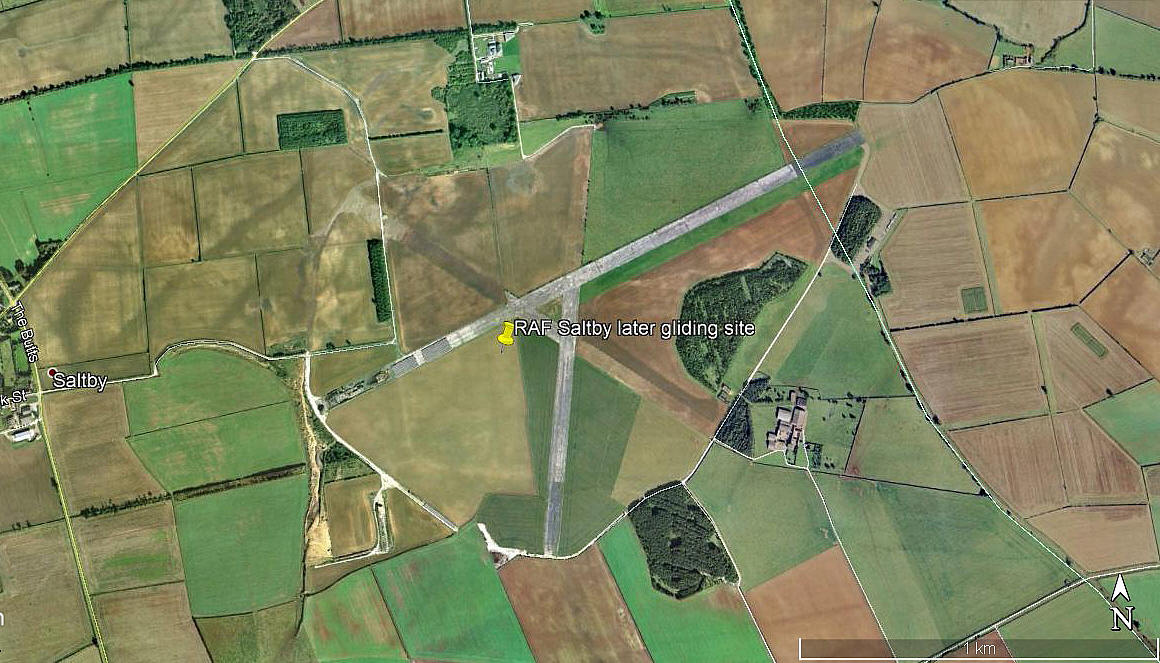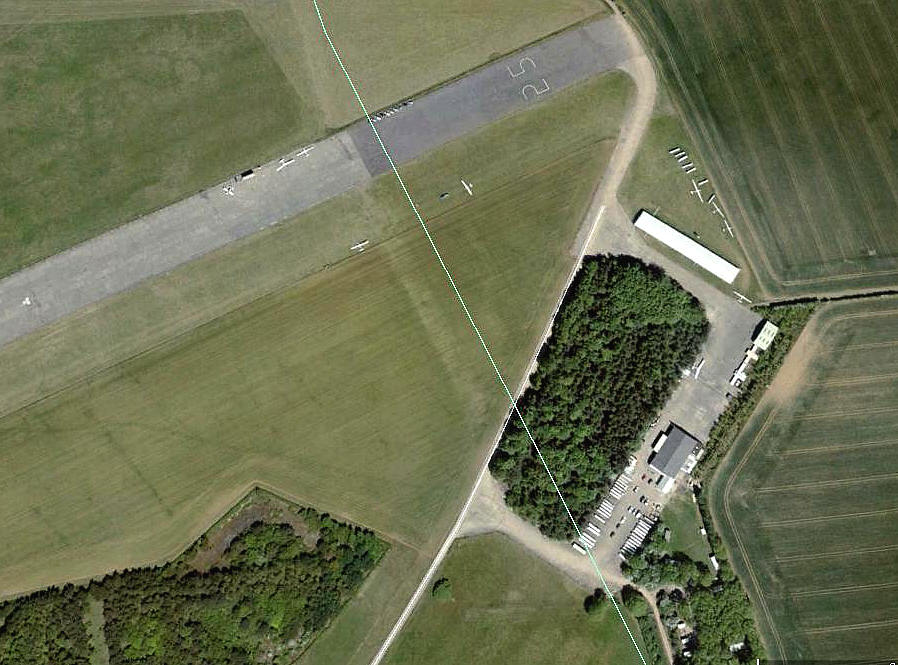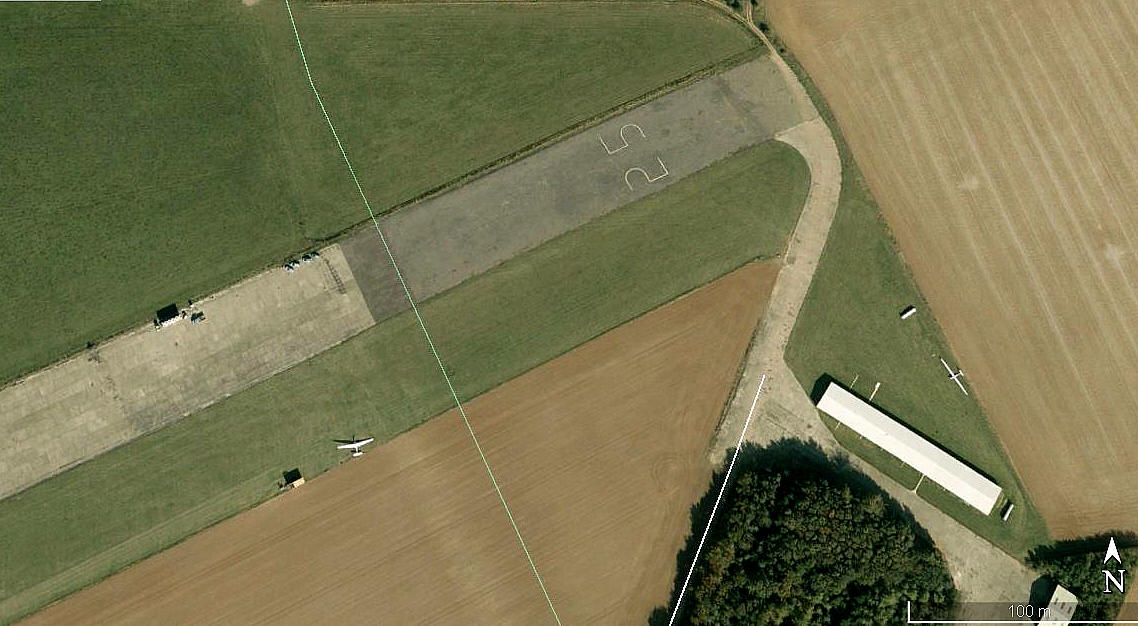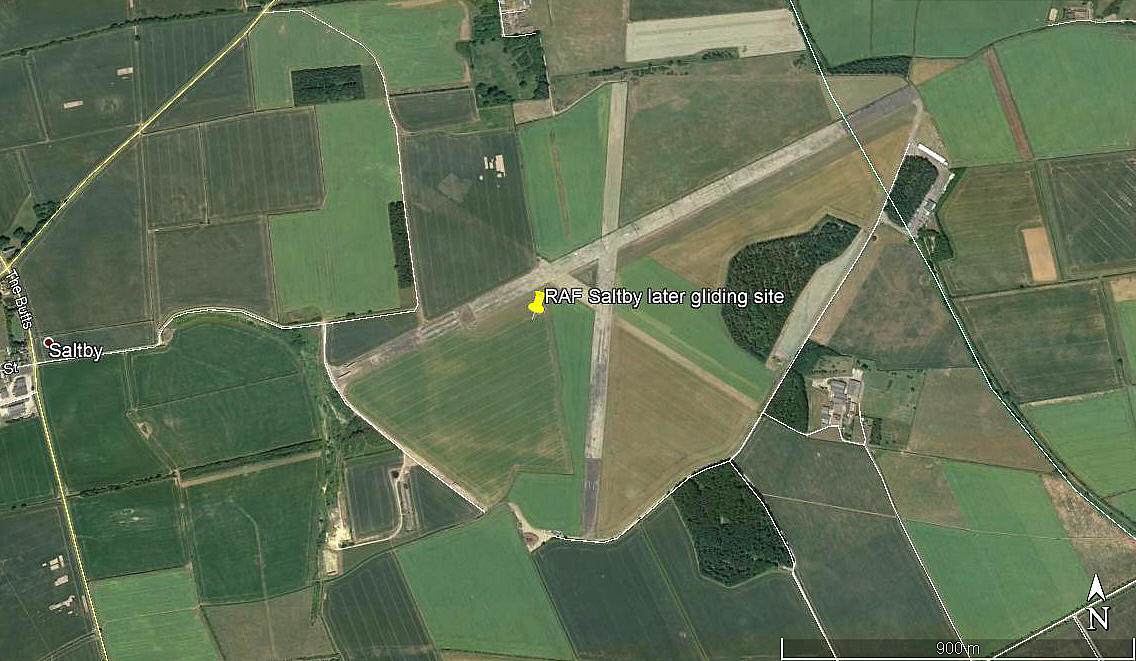Saltby
SALTBY: Military aerodrome much later gliding site
Note: All four of these pictures were obtained from Google Earth ©
Military users: WW2: RAF Bomber Command 5 and 92 Group
14 OTU
32 HGMS
1943 to 1945: 9th USAAF 52nd Troop Carrier Wing 314th & 349th TCG
32, 50, 61 & 62 TCS (C.47 Skytrains & C.53 Skytroopers)
1945: RAF Bomber and Transport Command 38 Group
1665 HCU (Halifaxs)
Gliding Club: Since 1971: Buckminster Gliding Club
Location: E of Saltby village, 7nm NE of Melton Mowbray
Period of operation: Military 1941 to 1945. (Some records state 1955). Since 1971 gliding site
Runways: WW2: Initially all-over grass airfield
1943: 01/19 1280x46 hard 07/25 1829x46 hard
13/31 1280x46 hard
2001: 02/20 800x30 hard 07/25 1200x45 hard + 07/25 950x50 grass
(S of hard runway)
NOTES: It was often the case during WW2 that various airfields had to help themselves growing crops due to the general food shortages. In 1942 the Saltby ‘vegetable garden’ raised 18,000 cabbages and 35 tons of potatoes! Camp personnel also helped local farmers to bring in the harvest in return for other provisions.
As Roy Bonsor says in his most excellent book which I relied on heavily for research into this part of the UK, ‘Aviation in Leicestershire and Rutland’, it does indeed seem “strange that while Saltby housed heavy bombers, control of the station was vested in Fighter Command”
AN INSIGHT
In his highly recommended book PILOT Joe Patient DFC gives an insight of what was required to convert to Halifax bombers, having had no experience of the type, let alone four engine bombers: “After release from my command of M Squadron GPR, (Joe had completed nearly two Tours on Mosquitos, then as an instructor on Wellingtons, then assigned glider duties), I was sent to 1665 HCU Saltby "where I flew the Halifax four-engined bomber" from the 17 July, 1945. On 19 July I was given nearly three hours familiarization, circuits and bumps on the Halifax with Flight Lieutenant Maloney DFC and the next day sent solo for just over an hour. Another two and a quarter hours solo next day was followed by night flying dual with Flight Lieutenant Clapperton for seventy minutes, followed by an hour’s solo.” And that was it!
“The very next day I joined 620 Squadron and flew with my crew to Brussels with some army chaps plus loads of kit, then on to Copenhagen and back to base. Then we went to an airfield called Schleswig-land on 23 July to pick up twelve RCAF men with their kit and obvious booty. I now had two days to get to know the crews of ‘A’ flight which I had taken over.”
ANOTHER INSIGHT
He also makes another point, after he was posted to the Middle East, which I believe is well worth recording. Especially regarding ‘friendly fire’. “During the time I spent in the Mediterranean I was surprised at the antipathy and, in some cases, the outright hostility shown to those arriving from Europe, both Army and RAF.” (My note – this was late 1945, early 1946). “Whether being fresh from home and receiving attention of the few women officers there caused the discord, I wouldn’t like to say, but the feeling certainly existed. The frequent and sarcastic ‘Get your knees brown’ remarks once provoked a well-decorated friend of mine to retort, ‘If the searchlights over Berlin had been ultra violet, I’d be a nigger by now.’ Many times I wondered if we had been fighting the same war. Much resentment was caused through unfortunate mishaps between the services. Army lads had been strafed by RAF aircraft and, to believe some reports, trigger-happy RN personnel are credited with shooting down more RAF planes than the Luftwaffe in the Mediterranean.”
This is of course an aspect of WW2, (or any war in the 20th century?), that the powers that be seem determined to bury - and still are, even in the 21st century. It does remain though a constant theme and the more you read accounts by aircrew, the more these reports come to light. I have even come across an instances when a top secret aircraft was being test flown at low level along the south coast of England, and specific instructions issued to give it free passage. Not only did the Army open fire, the RAF sent a squadron of Spitfires to intercept it!
Much today is made of how wonderful the British were at establishing communications systems. In some respects undoubtably true, but in others, obviously woefully inadequate. And of course, the question must be asked - WHY?
GETTING ACCUSTOMED TO 'CIVVIE' DUTIES
It was of course just such pilots and aircrews who were searching for jobs in the civil airlines after WW2. It must have been a difficult period for the airlines too? Where to get crews accustomed to flying safely? As had been mostly achieved prior to WW2 don’t forget.
The RAF had produced a regime nigh on guaranteed to ensure that no pilots and aircrew were competent to conduct safe civil operations when the war ended. And quite frankly, nothing resembling generally safe operation existed within their own ranks!But, hindsight is a most precious commodity. The concept of having highly adequate and accredited training in many if not most professions in aviation regarding safety as being paramount, probably didn’t occur until the 1970s? Indeed, the process is ongoing even today.
THE BRABAZON COMMITEE
The Brabazon Committee had been set up on the 23rd December 1942, (mark that date!), to investigate the needs the British Empire would require regarding civil aircraft. So, during the latter half of 1942, those in power in the British government at least, knew full well that the Nazi regime was finished. Without too much doubt the "One Thousand" bomber raids, the first starting on the 30/31 May 1942 attacking Cologne (Köln) and the last in August, surely indicated to the British that the war was now over and that we now held the upper hand. It really does seem incredible that, faced with this, the German population had to suffer so much more before the Nazi regime admitted defeat. Once the USA had joined sides surely the end result was inevitable?
Quite why the Nazi regime didn’t settle for a peace agreement in early 1943 remains an utter mystery? This said war-mongering fools such as Hitler are not easily dissuaded, as our own Prime Minister Tony Blair of similar ilk amply illustrated regarding Iraq and Afghanistan. What continues to intrigue me, and something I utterly fail to understand, is just how such people manage to gain power in the first place? But, as they say, "None are so blind as those who refuse to see."
A SINGULAR EVENT
On the 31st August 1970 special permission was granted for a C.130E Hercules (68-10948 ‘SR’) of the 62nd Tactical Airlift Squadron based at Mildenhall to land here for ‘Operation Sentimental Journey’ with many of the original WW2 people, (British and Americans), in various ways involved, including the publican of the nearby Crown Inn, attending the ceremony.
We'd love to hear from you, so please scroll down to leave a comment!
Leave a comment ...
Copyright (c) UK Airfield Guide



















